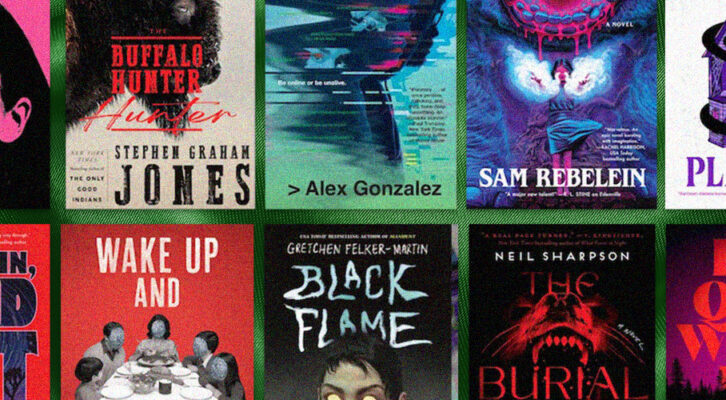
How Crossword Puzzles Underwrote Three of America’s Major Publishers
Natan Last on the Unlikely Origins of Simon & Schuster, Random House and Farrar, Straus and Giroux
One winter evening in 1924 Mr. Richard L. Simon came home from dinner at his aunt Wixie’s house with an idea.
He was a man of letters, now, and that’s why Wixie had invited him over. After Columbia and a tour in World War I, Simon had gone to work for a friend of his father’s—a sugar importer who liked the way Simon, born to a musical family, played the organ. Next he had a stint as a piano salesman. On a house call, he tried selling one to Max Lincoln Schuster, then an editor of an automotive magazine, who wasn’t buying. Spotting a copy of Romain Rolland’s Jean-Christophe, a novel about a German composer, Simon switched the conversation to books, and the two men bonded over mutual literary and musical tastes.
Simon stopped selling pianos and started selling books at Boni & Liveright (“BONE-eye,” “LIVE-right,” like a Pynchonesque law firm) and within a year, a promotion to sales manager at his back, he had amassed some $8,000 in savings and pledges from relatives and friends. It was the dawn of modernism; Horace Liveright had just then come back from Paris, where he’d offered T. S. Eliot a $150 advance to publish his book-length poem, The Waste Land, which one critic would later claim “may be a great poem; on the other hand it may be just a rather pompous cross-word puzzle.” Simon announced he was leaving Boni & Liveright to establish a publishing house with Max Schuster.
Simon & Schuster has never, in the century since its founding, not had a crossword puzzle book in print.
(“It’s a terrible time to walk out on me,” Liveright moaned. “Can you suggest anyone to replace you?” Simon called up his high school and college buddy, Bennett Cerf, who’d edited Columbia’s humor magazine, The Jester, and was then disentangling himself from a job at a Wall Street brokerage, where he’d gamely lost a good deal of money shorting the stock of Piggly Wiggly grocery stores. Cerf had always wanted to work in publishing and resented Simon’s meteoric rise in the industry, later grumbling “Dick Simon never read ten books through in his entire life.” After a strange courtship ritual—in which, as a favor to Liveright, Cerf accompanied the writer Theodore Dreiser to an afternoon baseball game that the latter man, bored, sulky, whisked them from around the sixth inning—Cerf took the job. Later, once Boni & Liveright went bankrupt and Cerf purchased the majority of their assets, he’d go on to found Random House. As smooth as an old-boy handshake: Liveright to Simon to Cerf.)
Simon and Schuster had a business license, an office on 37 West 57th Street, and a telephone operator. But they lacked a debut manuscript. At dinner that chilly January night, Aunt Wixie asked her nephew if he knew where she might buy a book of crossword puzzles; accounts vary as to whether she was asking for herself or for her niece. Either way, Simon was intrigued—there was no such book; maybe there ought to be—and soon he and Schuster were on their way from midtown to Newspaper Row, to consult the crossword experts of the World. Before meeting with Margaret Farrar (then Petherbridge) and her new editorial colleagues Prosper Buranelli and Gregory Hartswick (“surely a formidable trio of proper nouns,” Petherbridge to Buranelli to Hartswick), the pair looked in on their old pal, F.P.A.
“There are two friends of mine out here,” F.P.A. informed Farrar, “with an idea for a book. They’re nice guys but discourage them.”
F.P.A. was certain his colleagues would “lose their shirts.” The World, on hearing that sobering notion of a book of crosswords, pronounced it “the worst idea since Prohibition.” Sellers advised Simon and Schuster that the public wasn’t interested in puzzle books. Undeterred, the two men made an offer: Farrar, Buranelli, and Hartswick would be paid the “then-munificent advance” of $25 each to sift through the World ’s “drawerful of unpublished puzzles” and prepare fifty for the book; the authors of those puzzles would be paid nothing.
As publication drew nearer, Simon and Schuster began to have second thoughts. They might have seen galleys of their book-to-be, which lacked a traditional cover and instead nakedly displayed the collection’s first crossword, like a courtly fool stripped of his garments. The very first Down clue (called Vertical 1) came with a kind of talky preface from Farrar, Buranelli, and Hartswick, but it seemed almost designed to mock Simon and Schuster: “Now, VERTICAL 1—let’s see, an exclamation in two letters, beginning with H. Ha! Ha!” They worried they’d be pigeonholed, “typed as game-book publishers at the start” and “hooted out of the publishing business.” They spiraled, succumbing to “intimations of early bankruptcy,” felt they were courting “the disgrace of their good name,” these serious men of letters pumping the words SIMON and SCHUSTER with trivial hot air, until the letters were fat illegible balloons pricked into oblivion by a skyscraper’s spire. If the puzzle book was to enter the world stark-naked, the two men would duck beneath a cloak of pseudonymity. They set up a dummy imprint, Plaza Publishing, taken from the exchange of their telephone number: Plaza 6409.
When The Cross Word Puzzle Book was published on April 10, 1924, each edition included a Venus pencil. “One does not merely read The Cross Word Puzzle Book,” went a Simon & Schuster ad, “one writes in it. More than that one lives in it.” The book cost $1.35, steep for those days, perhaps anticipating a more affluent following, and was acquired primarily by mail order. Days later, Simon and Schuster couldn’t get into their office. A pile of orders, just under the mail slot, was blocking the door.
It’s hard to overstate the instant success of The Cross Word Puzzle Book. That first run of 3,600 copies sold briskly, the crossword grid transported by booksellers across and beyond the urban grid of New York; ten more printings quickly followed. Before the year was up, three more puzzle books were issued, available now at bookstores. On a single day before Christmas 1924, 150,000 copies left the shops for the fire-warmed, expectant hands of solvers. That year, three Simon & Schuster collections (they’d long since discarded the Thalia mask of Plaza Publishing) took the top three slots of the nonfiction bestseller list. For the second edition, priced more modestly at 25 cents, one eager distributor placed an order for 250,000—then the largest single purchase in publishing history. Simon & Schuster has never, in the century since its founding, not had a crossword puzzle book in print. One hundred thirty-three of them were edited by Margaret Farrar; she was compiling her 134th at the time of her death.
In this manner, the crossword puzzle launched three of the most prominent houses in American letters.
The economic impact is equally hard to overstate. For the house, of course, which always wins; Simon & Schuster netted some $600,000 in revenue by the close of 1924, around $10 million today. But also for the landscape of the publishing world. Given the gargantuan orders, Simon & Schuster agreed, in case of low sales, to take back unsold copies from bookstores—the first instance of a publisher allowing returns. The practice was designed to protect bookstores, back then much tinier mom-and-pop entities compared to the huge houses. But by the end of the twentieth century, after a consolidation spree, the sinewy mega- chains now held all the power, and could bully the atrophied publishing industry with the risk of returning huge orders to the houses.
The literary landscape would shift yet again after Margaret Petherbridge married John C. Farrar in 1926, swapping her formidable name for his. Her father had taken her substantial royalties from The Cross Word Puzzle Book and invested them in U.S. Steel and Standard Oil. Years later, she would use this money to underwrite her husband’s publishing business. In this manner, the crossword puzzle launched three of the most prominent houses in American letters: Simon & Schuster, directly, through bestselling compendia of crosswords; Random House, indirectly, since Dick Simon handpicked Bennett Cerf as his replacement when the former went into business with Schuster; and Farrar, Straus and Giroux, financed by crossword money augmented by stocks in the age’s oil and steel behemoths. A city of words on a bedrock of black-and-white.
Among the totems, knickknacks, and ephemera in Will Shortz’s home-cum-museum, and one of his favorite items, is a copy of the 1924 book inscribed by Dick Simon and Max Schuster, sent to its source of inspiration. “To Aunt Wixie,” the inscription reads,
whose idea, announced on January 3, has finally taken material form in this first copy of the first edition of the first publication of
Simon and Schuster Inc.
Alias The Plaza Publishing Co.
With many thanks
Dick Max
__________________________________

Excerpted from Across the Universe: The Past, Present, and Future of the Crossword Puzzle by Natan Last. Reprinted by permission of Pantheon Books, an imprint of the Knopf Doubleday Publishing Group, a division of Penguin Random House LLC. Copyright © 2025 by Natan Last.
Natan Last
Natan Last is a writer and immigration policy advocate. He writes bimonthly crosswords for The New Yorker. His essays, poetry, and academic research appear in The New Yorker, The New York Times, The Drift, Los Angeles Review of Books, Hyperallergic, Narrative, and elsewhere. He has worked for the UN, the Asylum Seeker Advocacy Project, the International Rescue Committee, and as an advisor to the federal government on refugee resettlement. He lives in his native Brooklyn.



















